Why Medical Stretchers Are Critical for Patient Care and Staff Safety
Top Choice for medical stretchers depends on your facility's specific needs, but industry leaders consistently recommend Stryker's Prime Series and M-Series, Hill-Rom's P8000 series, and Hausted's specialized procedure chairs for their proven reliability, advanced safety features, and superior patient comfort.
Quick Answer - Top Medical Stretcher Brands:
- Stryker Prime Series - 700 lbs capacity, Zoom motorized drive, StayPut retention system
- Hill-Rom P8000/P8005 - 500-700 lbs capacity, hydraulic height adjustment, Trendelenburg controls
- Hausted Horizon Series - Specialized eye and procedure stretchers with advanced positioning
- Ferno PowerFlexx - Automatic loading ambulance stretchers with 700 lbs capacity
- Techlem Transport - Adjustable backrests, locking brakes, fold-down side rails
Medical stretchers serve as the backbone of patient transport in hospitals, emergency services, and specialized care facilities. They're far more than simple wheeled beds - modern stretchers integrate powered drive systems, electronic braking, patient positioning controls, and safety restraints that directly impact both patient outcomes and caregiver wellbeing.
As one healthcare professional noted: "We don't usually think of stretchers as critical health care equipment, but finding the right option of the right quality makes a significant difference in clinical outcomes." Research shows that proper stretcher selection can reduce staff injuries by up to 40% while improving CPR effectiveness and patient comfort during transport.
The stretcher market has evolved dramatically, with manufacturers now offering specialized solutions for bariatric patients (supporting up to 1000 lbs), MRI-compatible non-magnetic designs, and eye surgery platforms with precision head positioning. Powered stretchers with motorized height adjustment and drive assistance have become increasingly popular, reducing the physical strain on healthcare workers during frequent patient transfers.
I'm Mortuary Cooler, a national level mortuary cooler supplier with experience in medical transport equipment. Through years of working with funeral homes, hospitals, and emergency services, I've seen how the Top Choice for medical stretchers varies significantly based on patient population, facility layout, and operational workflow. My background in heavy-duty medical equipment helps healthcare facilities select stretchers that balance durability, functionality, and long-term value.
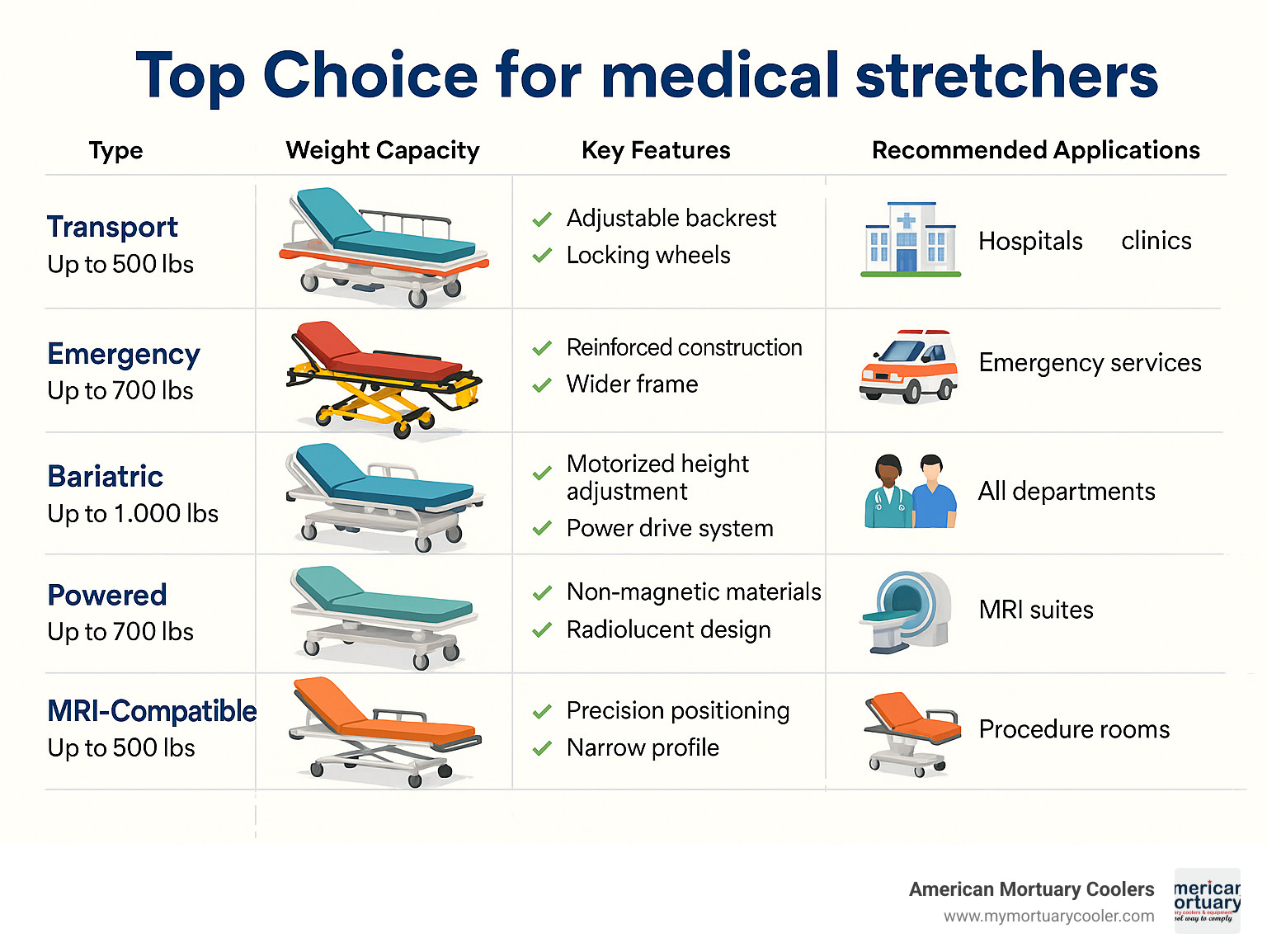
Relevant articles related to * Top Choice for medical stretchers*:
- the ultimate guide to choosing the right stretcher
- a practical guide to funeral home supplies medicalstretchers.com
- the ultimate guide to buying keds at medicalstretchers.com
Understanding Medical Stretchers: Core Uses & Major Types
When you walk through any hospital, you'll see medical stretchers everywhere - but these aren't just fancy wheeled beds. Medical stretchers are specialized patient transport platforms designed specifically for healthcare environments where every detail matters for patient safety and caregiver wellbeing.
Think of medical stretchers as the workhorses of healthcare facilities. Unlike the basic EMS cots you see in ambulances or the heavy-duty mortuary stretchers used in funeral homes, hospital stretchers need to handle constant daily use while maintaining patient comfort during procedures, emergency interventions, and recovery periods.
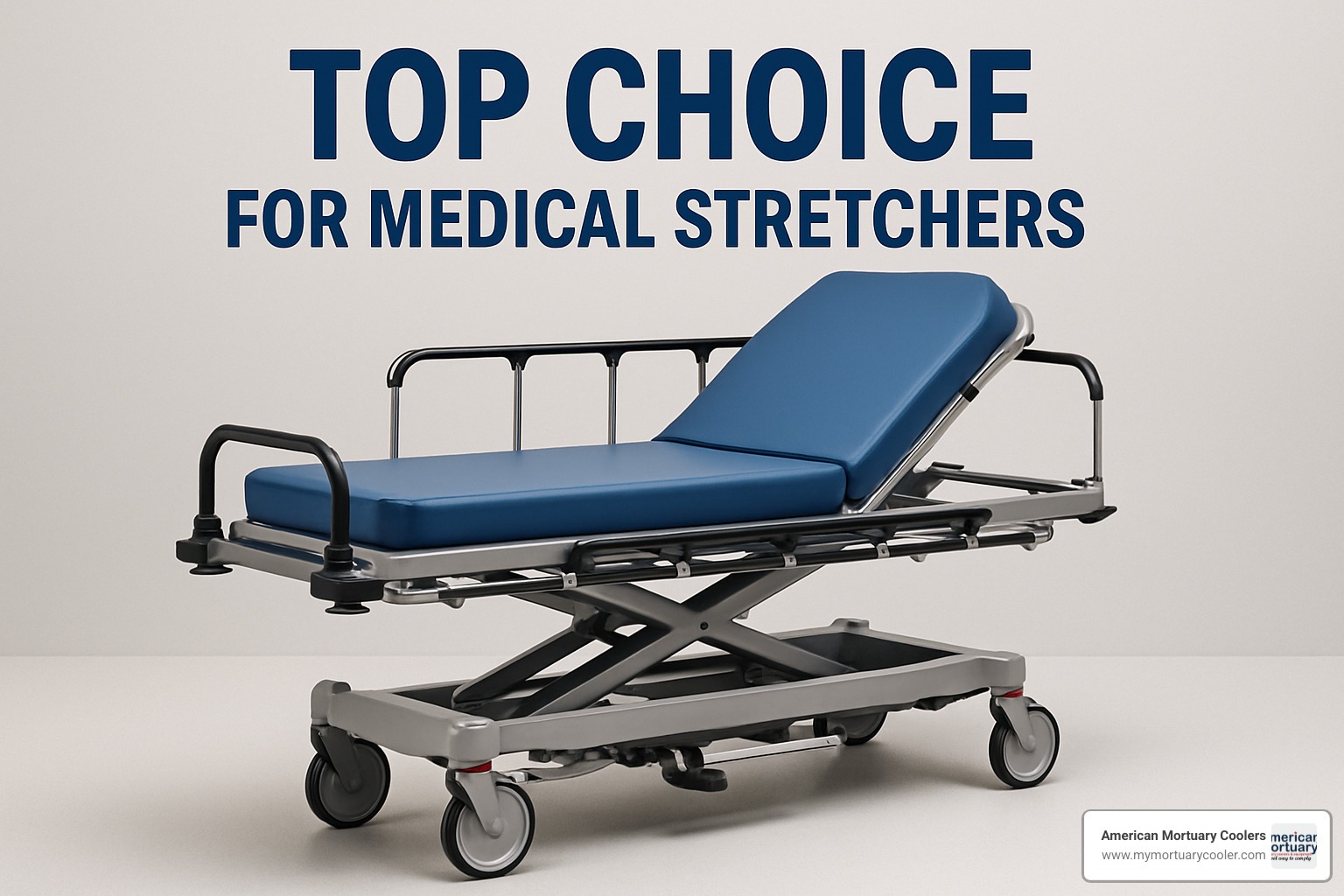
The engineering behind modern stretchers is pretty impressive. Most feature adjustable backrests for patients with breathing difficulties, safety belts and side rails for secure transport, and fifth wheel steering that reduces the push force needed by up to 60%. That last feature might sound technical, but it's a game-changer for nurses who move patients dozens of times per shift.
Weight capacity becomes crucial when selecting stretchers. Standard transport models typically support 350-500 lbs, while bariatric stretchers can handle patients up to 1000 lbs or more. Many also offer Trendelenburg positioning (that's medical speak for tilting the patient at specific angles - usually ±17-18°) which helps manage shock and improve circulation during emergencies.
What Is a Medical Stretcher?
A medical stretcher is essentially a wheeled medical device designed for moving patients who can't walk on their own and need medical care during transport. Don't confuse these with those consumer back stretchers you might find on Amazon for lower back pain relief - hospital stretchers are serious medical equipment.
These devices integrate multiple sophisticated systems working together. You'll find hydraulic or pneumatic height adjustment for proper ergonomics, electronic braking mechanisms for safety, patient restraint systems for security during transport, and accessory mounting points for IV poles, oxygen cylinders, and monitoring equipment.
The construction typically uses aircraft-grade aluminum alloy or steel for the perfect balance of strength and weight. After all, these stretchers need to support heavy patients while remaining light enough for caregivers to maneuver easily through narrow hospital corridors.
Side-by-Side of Key Stretcher Classes
Understanding the different types of stretchers helps you identify the Top Choice for medical stretchers for your specific needs. Transport stretchers handle basic inter-department movement with weight capacities of 350-700 lbs and typically cost $3,000-$8,000. These workhorses feature fifth wheel steering and retractable rails for everyday hospital use.
Procedural stretchers step up the game for minor procedures and recovery situations. With 500-700 lb capacity and adjustable positioning capabilities, they range from $5,000-$15,000 and often include stirrups for various medical procedures.
Emergency and trauma stretchers are built for critical care situations where every second counts. These $8,000-$20,000 units provide full X-ray access and rapid positioning capabilities while supporting 500-700 lbs. They're designed specifically for CPR support and emergency interventions.
Bariatric stretchers address the growing need for larger patient transport. With reinforced frames supporting 700-1000+ lbs and extra width for patient dignity, these specialized units cost $10,000-$25,000 but are essential for comprehensive patient care.
Specialty stretchers like MRI-compatible and eye surgery models represent the high-end of stretcher technology. Using non-magnetic materials and precision positioning systems, these $12,000-$30,000 units serve very specific medical procedures where standard stretchers simply won't work.
More info about stretcher types
Top Choice for Medical Stretchers: Best Brands, Models & Why They Stand Out
After working with healthcare facilities across Tennessee, Georgia, Illinois, and beyond, I've seen which stretcher brands truly deliver when it comes to patient safety and caregiver comfort. While every facility has unique needs, certain manufacturers consistently rise to the top for their reliability, innovation, and real-world performance.
Stryker leads the premium market with their Prime Series and M-Series stretchers, and for good reason. The Stryker M-Series Transport Stretcher handles up to 700 lbs, features a dual cylinder pneumatic backrest, and includes four-wheel steel-ring brakes that actually work when you need them most. Healthcare professionals consistently tell me: "The Stryker M-Series is an excellent choice for medical professionals" - and I've rarely heard complaints about their durability, even after years of heavy use.
Hill-Rom (now part of Baxter) brings thoughtful engineering to their P8000 and P8005 series. These stretchers offer flexible weight capacity options of 500 or 700 lbs, hydraulic height adjustment that's smooth and reliable, and one-handed side rail release that busy nurses actually appreciate. The P8005 takes things further with pneumatic backrest controls and Trendelenburg positioning, plus a retractable fifth wheel that makes navigating tight hospital corners much easier.
Hausted has carved out a specialty niche, particularly excelling in procedure-specific applications. Their Horizon Series shines in eye surgery and imaging applications, offering hydraulic positioning with specialized head sections and radiolucent components for fluoroscopy procedures. When precision matters most, Hausted delivers.
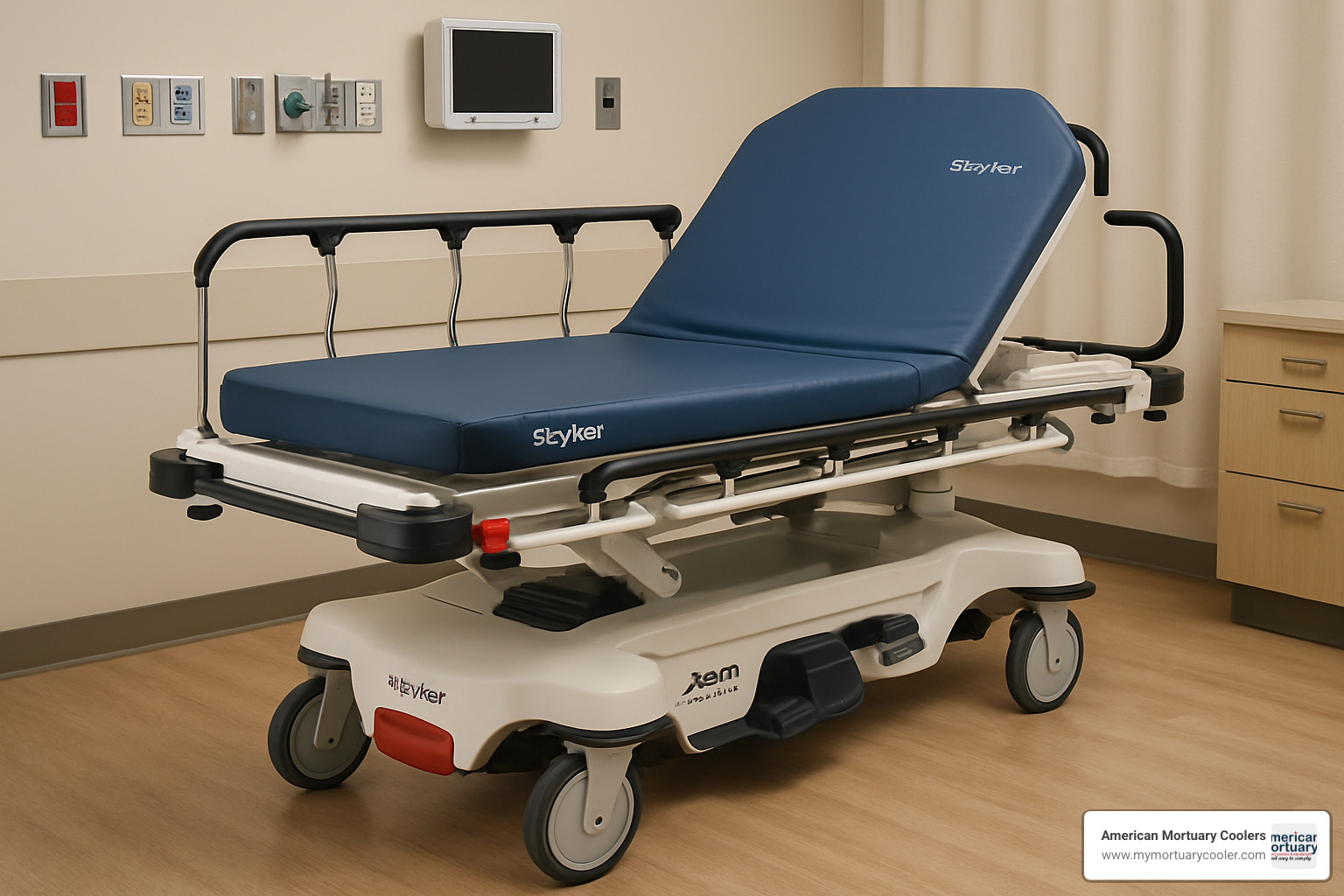
Techlem has quietly become a North American leader by focusing on what healthcare workers actually need: adjustable backrests for patient comfort and comprehensive safety features that work in real emergencies. Their transport stretchers include reliable locking brakes and fold-down side rails, while their surgical models feature electric height adjustment via foot pedal and radiolucent backrests for intraoperative imaging.
Ferno brings ambulance expertise to hospital settings with their PowerFlexx series, while Gendron and TransMotion round out the field with specialized solutions for unique transport needs. Each brand has found its sweet spot in the market.
A Quick Start Guide to the Best Medical Stretchers
Powered Excellence – The Zoom & Power-Pro Lines
When I talk to facilities about their Top Choice for medical stretchers, powered models increasingly top the list - especially in high-volume environments where staff safety isn't just important, it's critical. The Stryker Prime Series with Zoom Motorized Drive System represents the gold standard here, dramatically reducing the physical effort required by healthcare professionals while improving transport efficiency.
These powered systems typically include integrated scales for patient weighing without transfers, battery-powered height adjustment that eliminates manual cranking, motorized drive assistance for easier navigation through crowded hallways, and electronic positioning controls for precise patient placement during procedures.
The numbers don't lie - research shows that powered stretchers can reduce staff injuries by up to 40%. That's not just a statistic; that's fewer workers' compensation claims, less staff turnover, and healthier caregivers who can focus on patient care instead of nursing sore backs. The Ferno PowerFlexx ambulance stretcher demonstrates this technology beautifully with its 700 lbs lift capacity and automatic loading capabilities.
Yes, powered stretchers cost more upfront. But when you factor in reduced injury rates and improved staff satisfaction, they often pay for themselves within the first few years of use.
Bariatric Leaders – Wide & 1000-lb Capacity Platforms
The reality of modern healthcare includes caring for larger patients with dignity and safety. Bariatric stretchers represent the Top Choice for medical stretchers when standard equipment simply isn't adequate. The Gendron 1190 and Hill-Rom P8005 lead this category with thoughtful design that addresses real-world challenges.
These specialized stretchers feature reinforced frames with weight capacities up to 1000 lbs, extra-wide patient surfaces (typically 32-36 inches versus standard 29 inches), improved stability through lower center of gravity design, and specialized padding for pressure distribution and comfort.
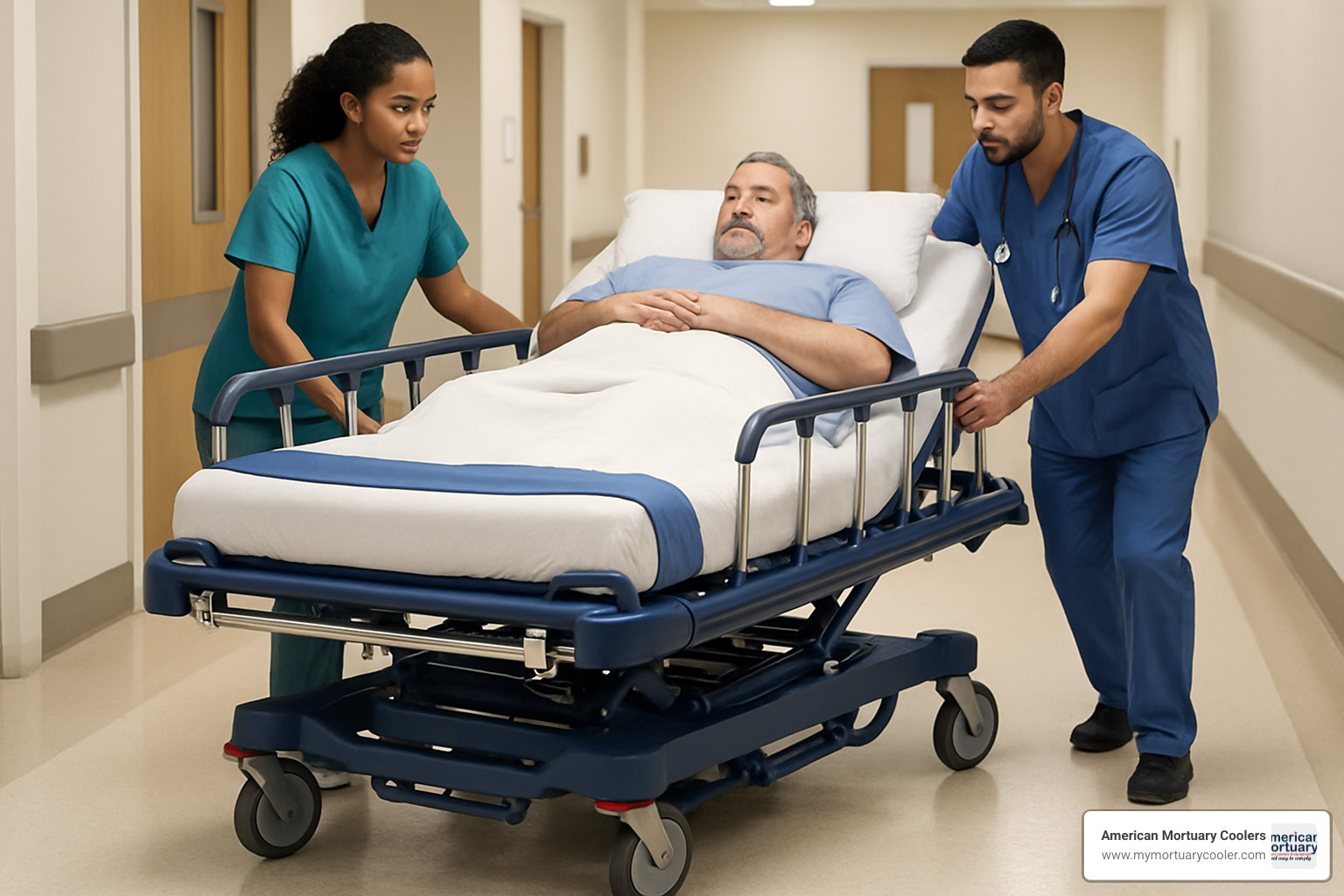
One healthcare facility manager told me: "Our investment in properly designed bariatric stretchers has dramatically reduced workplace injuries related to patient handling." These stretchers ensure both patient dignity and staff safety when transporting individuals who exceed standard weight limits. The StayPut retention system featured on many bariatric models provides additional security during transport.
Specialty Standouts – MRI, Eye, OB/GYN
Some medical situations demand stretchers designed for very specific purposes. MRI-compatible stretchers use non-magnetic materials (typically aluminum and specific plastics) to prevent dangerous interference with powerful imaging equipment. The Ferno 35A MR Conditional Cot exemplifies this specialized engineering.
Eye surgery stretchers require precision that standard models can't provide. The Stryker 1068 Eye Surgery Stretcher and Hausted 5E8 Power Eye stretcher feature dual-articulating head sections, specialized padding, and equipment accommodation space for the delicate positioning critical to successful ophthalmic procedures.
OB/GYN stretchers need to convert seamlessly between transport and examination modes. These versatile units include folding stirrups, catch basins, and specialized positioning capabilities for pelvic examinations and maternity care. This convertible design eliminates risky manual patient transfers between different pieces of equipment.
Each specialty stretcher addresses specific clinical requirements that general transport models simply cannot handle. While they represent a significant investment, the improved patient outcomes and procedural efficiency they enable often justify their cost in specialized departments.
Key Features & Innovations That Define a Top Choice
When you're choosing medical stretchers, you're really making three important decisions at once: how comfortable your patients will be, how safe your staff will stay, and how smoothly your facility will run. The Top Choice for medical stretchers today goes far beyond just wheels and a bed surface.
Let's start with the basics that aren't so basic anymore. Weight capacity used to be a simple number on a spec sheet. Now it's integrated with smart engineering like Stryker's StayPut™ Retention System that keeps patients secure without making them feel trapped. The Stryker Prime Series handles 700 lbs while giving staff the Zoom™ Motorized Drive to make those heavy transports feel effortless.
Here's something that might surprise you: fifth-wheel steering can cut your pushing effort by more than half. The Hill-Rom P8005's retractable fifth wheel transforms those awkward hallway turns from a two-person struggle into a smooth one-handed maneuver. After watching countless staff members wrestle stretchers around tight corners, this innovation feels like a genuine game-changer.

Motorized assistance has moved from luxury to necessity in many facilities. When you're making dozens of patient transfers daily, powered height adjustment saves your staff's backs from all that manual cranking. The motorized drive systems help steer those endless hospital corridors without leaving anyone exhausted by lunchtime.
Modern safety features work smarter, not harder. Central locking brakes secure all wheels with one motion instead of requiring staff to crawl around checking each wheel individually. Side rails release with one hand but stay locked when they need to - no more fumbling with complicated mechanisms during emergencies.
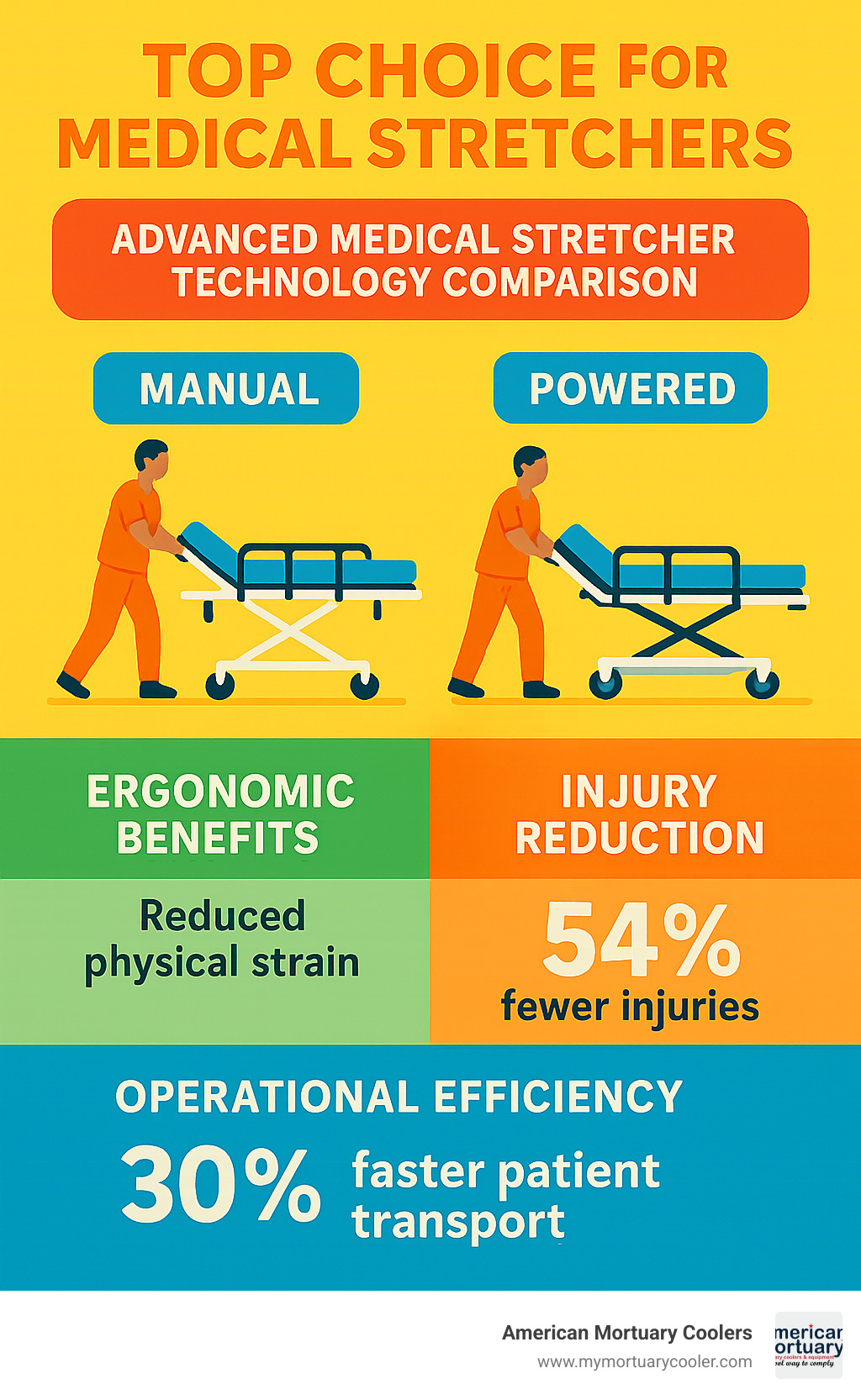
Antimicrobial surfaces and integrated scales round out the innovation picture. You can weigh patients without transfers and clean surfaces that actively resist bacterial growth. These aren't flashy features, but they solve real daily problems that add up to better patient care.
Scientific research on ergonomic handling continues to drive these improvements, showing measurable benefits in both patient outcomes and staff safety metrics.
Patient Comfort & Safety by Design
Your patients notice every detail, even when they're not feeling their best. Modern stretchers typically feature 3-inch thick mattresses with pressure-relieving properties - a significant upgrade from the thin padding that used to pass for comfort.
Patient positioning capabilities have become remarkably sophisticated. Trendelenburg angles of ±17-18° help manage shock and improve circulation during emergencies. Backrest adjustment ranges from completely flat to 90° upright, letting patients with breathing difficulties find their most comfortable position.
The height adjustment range typically spans 24-36 inches, which means staff of different heights can work comfortably while patients can transfer more easily at lower positions. Lateral tilt options help with procedures and patient positioning without requiring multiple transfers.
Modern restraint systems balance security with dignity beautifully. Quick-release safety belts let staff respond instantly during emergencies while keeping patients secure during routine transport. The days of complicated buckles and uncomfortable straps are thankfully behind us.
Side-rail design has evolved to provide security without making patients feel caged. One-handed release mechanisms mean staff can lower rails quickly when needed, but they stay firmly locked during transport.
Caregiver Ergonomics & Maneuverability
Here's a statistic that tells a story: facilities report up to 40% fewer staff injuries after upgrading to modern ergonomic stretchers. That's not just numbers - that's real people going home without back pain after long shifts.
Push force reduction through improved wheel design and powered assistance makes a dramatic difference in daily operations. Some staff members describe the difference as "night and day" when moving from manual to powered systems.
Steering improvements include omni-directional casters (usually 8-inch diameter) that glide smoothly across different floor surfaces. Whether you're moving from carpet to tile or navigating those inevitable elevator thresholds, modern wheels handle the transitions without jarring stops or difficult pushing.
The injury reduction statistics speak volumes about why ergonomic features matter. When your staff can move patients safely and comfortably, everyone benefits - patients get smoother transport, staff stay healthier, and facilities see fewer workers' compensation claims.
Maneuverability improvements like fifth-wheel systems provide precise directional control that reduces the physical effort required for navigation. These systems typically retract when not needed, so they don't interfere with normal operation but deploy instantly when you need that extra steering precision.
Ownership, Maintenance & Cost Considerations
Let's talk money - because medical stretchers are a serious investment. We're looking at anywhere from $3,000 for a basic transport model to over $25,000 for those fancy powered units with all the bells and whistles. When you're trying to figure out the Top Choice for medical stretchers for your facility, understanding the total cost of ownership becomes crucial.
Here's something that might surprise you: durability varies dramatically between brands. Stryker and Hill-Rom stretchers typically keep rolling strong for 10-15 years with proper care, while some budget alternatives start showing their age in just 5-7 years. Aircraft-grade aluminum frames generally outlast steel construction, though they cost more upfront.
The real eye-opener? Preventive maintenance can extend your stretcher's lifespan by 40-50%. That's not just manufacturer marketing speak - it's backed by industry data. We're talking about simple things like daily cleaning with approved disinfectants, weekly lubrication of moving parts, and monthly check-ups of structural components and batteries.

Lifecycle costs tell the real story though. You've got your initial purchase, ongoing maintenance, unexpected repairs, and eventual replacement. Powered stretchers need more TLC - battery replacements and electronic servicing add up - but they often provide better ROI through reduced staff injury costs and smoother operations.
Medical Stretcher vs Mortuary Stretcher: Understanding the Heavy Duty Differences
Routine Maintenance & Cleaning Protocols
Think of stretcher maintenance like taking care of your car - skip the oil changes, and you'll pay for it later. Healthcare facilities need solid maintenance schedules based on how hard their equipment works and what the manufacturer recommends.
Every single day, your staff should do a quick visual check for loose parts or damage, test those brakes before each shift starts, clean everything with the right disinfectants, and make sure powered units have enough battery charge. It takes maybe 10 minutes but saves thousands in repairs.
Weekly tasks get a bit more involved. Someone needs to lubricate moving parts, inspect wheels and casters for wear, test safety rail operation, and check that accessory mounting points are still solid. This is when small problems get caught before they become big headaches.
Monthly maintenance is where you dig deeper. Structural inspections, hydraulic pressure testing, electronic system diagnostics, and replacing parts before they fail. It's like a physical for your stretchers - catching issues early keeps everyone safe and saves money.
Balancing Budget & Value Over Time
Here's where things get interesting. Most healthcare facilities wrestle with tight budgets versus long-term value. Refurbished stretchers from reputable suppliers can save you 60-70% while still delivering solid reliability - especially perfect for facilities with moderate usage.
Financing options help spread those costs across multiple budget cycles instead of one massive hit. Many suppliers offer lease programs that bundle maintenance contracts, giving you predictable monthly expenses rather than surprise repair bills.
Service contracts typically run 8-12% of the purchase price annually, but they're like insurance for your equipment. They prevent those unexpected repair nightmares and keep you compliant with regulations through scheduled inspections.
Frequently Asked Questions about Medical Stretchers
What weight capacity do I need? Standard 500 lb capacity works for most patients, but if you serve diverse populations, consider 700 lb models. Facilities with bariatric programs absolutely need those 1000+ lb specialized units.
Are powered stretchers worth the investment? For busy facilities handling more than 20 transports daily, powered stretchers typically pay for themselves within 2-3 years through reduced staff injury costs and improved efficiency. Less busy facilities might stick with manual models.
How often should stretchers be serviced? Monthly preventive maintenance plus annual comprehensive inspections keep everything running smoothly and meet regulatory requirements. High-usage stretchers might need attention more frequently - listen to your equipment, and it'll tell you what it needs.
Conclusion
Finding the Top Choice for medical stretchers isn't just about picking the most expensive model or the one with the most bells and whistles. It's about understanding what your patients need and what your staff can realistically handle day after day.
Through our years working with healthcare facilities from our Tennessee headquarters to installations across Georgia, Illinois, and throughout the country, we've watched countless facilities transform their patient care simply by choosing the right stretcher. The difference between a struggling transport process and a smooth one often comes down to this single decision.
Stryker's Prime Series continues to lead when facilities need powered reliability, while Hill-Rom's P8000 series offers that sweet spot of versatility without breaking the budget. Hausted remains unbeatable for specialized procedures, and Techlem has quietly become the go-to choice for facilities that prioritize patient comfort above all else.
Here's what we've learned matters most: weight capacity should exceed your current needs by at least 100 pounds, powered features pay for themselves in facilities doing more than 20 transports daily, and the maintenance protocol you actually follow beats the perfect one you ignore.
At American Mortuary Coolers, we might specialize in custom mortuary equipment, but heavy-duty medical transport is heavy-duty medical transport. The same engineering principles that make our mortuary coolers last decades in funeral homes apply to stretchers working around the clock in hospitals. Durability, reliability, and thoughtful design matter whether you're moving patients between departments or serving families during difficult times.
The real cost of your stretcher isn't the purchase price - it's the total of everything that happens over the next 10-15 years. Factor in the maintenance visits, the staff training, the potential injury costs, and yes, the peace of mind that comes from knowing your equipment won't fail when someone's life depends on it.
When you're ready to make that investment in the Top Choice for medical stretchers, the best choice is the one that fits your specific situation perfectly. Not the one that looks best in the catalog, but the one that will still be running smoothly on your busiest day five years from now.
















